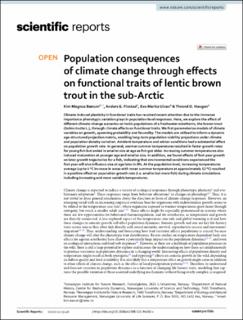Population consequences of climate change through effects on functional traits of lentic brown trout in the sub-Arctic
Peer reviewed, Journal article
Published version
Permanent lenke
https://hdl.handle.net/11250/2981395Utgivelsesdato
2021Metadata
Vis full innførselSamlinger
Sammendrag
Climate-induced plasticity in functional traits has received recent attention due to the immense importance phenotypic variation plays in population level responses. Here, we explore the efect of diferent climate-change scenarios on lentic populations of a freshwater ectotherm, the brown trout (Salmo trutta L.), through climate efects on functional traits. We frst parameterize models of climate variables on growth, spawning probability and fecundity. The models are utilized to inform a dynamic age-structured projection matrix, enabling long-term population viability projections under climate and population density variation. Ambient temperature and winter conditions had a substantial efect on population growth rate. In general, warmer summer temperatures resulted in faster growth rates for young fsh but ended in smaller size at age as fsh got older. Increasing summer temperatures also induced maturation at younger age and smaller size. In addition, we found efects of frst-year growth on later growth trajectories for a fsh, indicating that environmental conditions experienced the frst year will also infuence size at age later in life. At the population level, increasing temperatures average (up to 4 °C increase in areas with mean summer temperature at approximately 12 °C) resulted in a positive efect on population growth rate (i.e. smaller but more fsh) during climate simulations including increasing and more variable temperatures.
